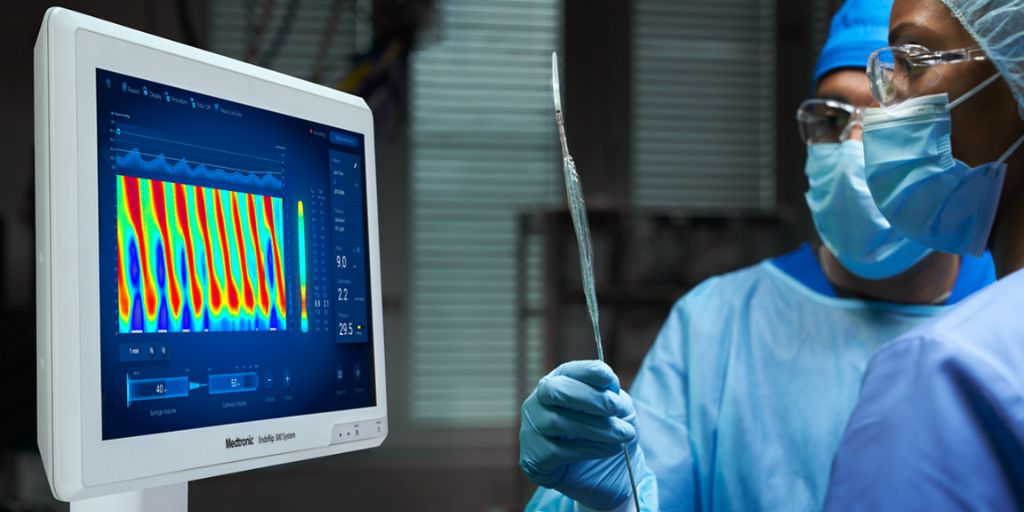
Medtronic, a global leader in healthcare technology, announced today it has received CE Mark approval for its next generation EndoflipTM 300 system. Endoflip is an advanced diagnostic tool that can help expedite accurate diagnosis of oesophageal motility disorders, conditions often missed during endoscopies. It works by measuring pressure and dimensions in the oesophagus and pylorus.
“Medtronic is committed to transforming oesophageal care for patients by providing physicians with cutting-edge solutions to their clinical challenges,” comments Darin Wilson, Medtronic Endoscopy Business Unit Leader, Western Europe. “We are excited to have received CE Mark approval for Endoflip™ 300, which will help gastroenterologists & GI surgeons across Europe diagnose oesophageal motility disorders much earlier, plan and implement precise and effective treatment and, ultimately, improve patient outcomes. We are fuelled by our resolve to change each individual’s life for the better and strive to achieve this through continued technological innovation.”
The Endoflip 300 System will help thousands of patients across Europe with oesophageal motility disorders achieve a diagnosis. Oesophageal motility disorders affect the normal functioning of the oesophagus, disrupting the normal swallowing process (peristalsis) causing symptoms such as difficulty swallowing (dysphagia), chest pain, regurgitation, and heartburn. These disorders, chiefly achalasia (with a prevalence of up to 15.7 per 100,000) and gastroparesis (with a prevalence of 13.8 per 100,000 in Europe) are misdiagnosed in up to 50% of endoscopies. This means, in Europe alone, there could be thousands more people living with these conditions that haven’t been diagnosed.
Because symptoms can overlap with more common conditions such as gastro-oesophageal reflux disease (GORD), patients can wait years to receive a diagnosis. This can lead to unnecessary tests which can cause distress and cost money. Depending on the healthcare system and whether procedures are performed publicly or privately costs can vary, however, upper GI endoscopies typically cost €2,000 – €4,000 in Western Europe, and sometimes as much as €7,000. Meanwhile, patients deteriorate and they suffer reduced quality of life due to ongoing symptoms.
Timely diagnosis of these conditions is key to improving patient outcomes. As pinpointing the underlying cause of patient symptoms can be very difficult, Endoflip represents a valuable tool as a convenient, well tolerated method for assessment. Endoflip can be performed under sedation in around 5 minutes and can be utilised from the very first endoscopy. The device uses a balloon catheter to display diameter estimates of the measurement area in real-time. It can measure and display diameter estimates at up to 16 points within the balloon while also displaying balloon pressure. This may allow for a more precise diagnosis and treatment planning from the very first endoscopy, preventing unnecessary distress for patients.
Dr. Rehan Haidry, Clinical Lead of Endoscopy and Consultant Gastroenterologist at the Cleveland Clinic, London adds: “EndoflipTM is a game changer for us. Oesophageal motility disorders, like achalasia and gastroparesis, are notorious for being hard to spot and patients are often given the wrong diagnosis. I’ve seen patients with symptoms for over a decade, undergoing numerous inconclusive endoscopies. EndoflipTM provides us with a significant advantage: by guiding diagnosis and treatment early on, EndoflipTM can drastically improve patient outcomes.”
Professor Silvana Perretta, Upper gastro-intestinal surgeon, from the Nouvel Hôpital Civil (NHC) University Hospital, Strasbourg concludes: “Incorporating EndoflipTM technology for perioperative use provides an additional functional tool that enhances diagnostic accuracy and helps prevent misdiagnosis and therefore mistreatment. In surgery there is no room for approximation. This innovation is pivotal in delivering more precise care, particularly in the era of precision surgery and treatment. A smart imaging probe for smart diagnosis can save health care dollars and improve patient’s lives”.












